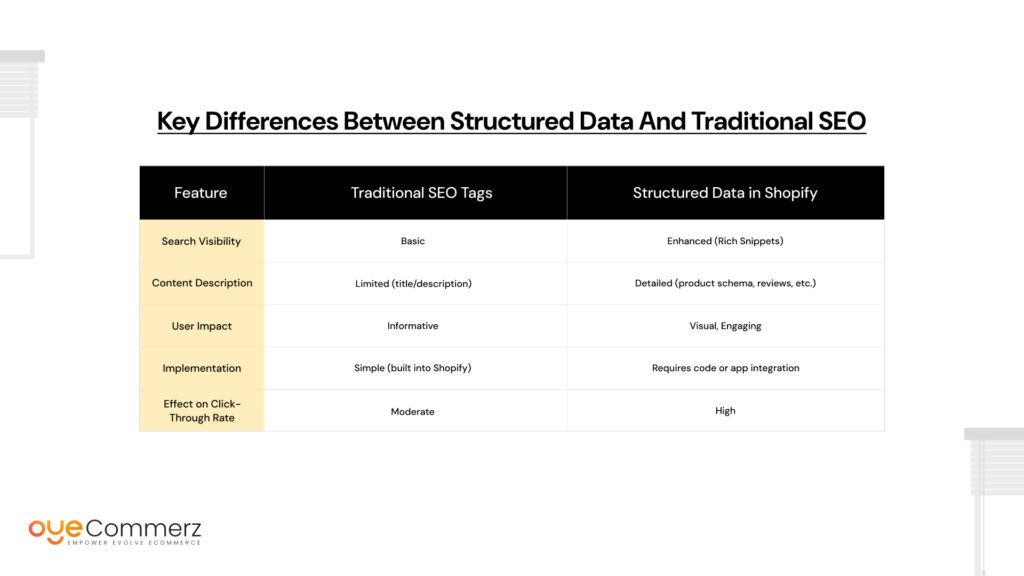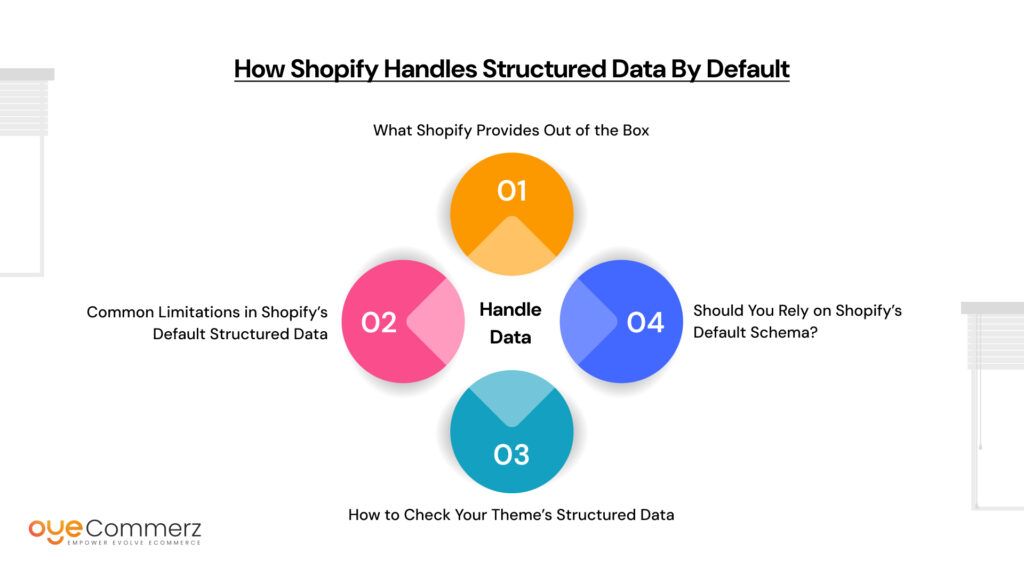In today’s competitive e-commerce landscape, standing out in search results is more critical than ever. Yet, many Shopify merchants are unaware of a simple yet powerful SEO tactic structured data.
If your product listings aren’t showing rich snippets like star ratings, pricing, availability, or breadcrumbs in Google search results, your store is likely blending into the background. That means fewer clicks, lower conversions, and missed sales opportunities.
In this step-by-step guide, we’ll show you how to implement Structured Data in Shopify whether you’re just starting your online business or looking to optimize an established store. You’ll learn what structured data is, how it works, and how to implement it manually or with apps.
If you’re migrating to Shopify or planning to, we’ll also introduce how Oyecommerz can support your transition while setting up your store for maximum SEO performance from day one.
Table of Contents
ToggleWhat Is Structured Data and Why It Matters for Your Shopify Store
Structured Data in Shopify refers to a standardized format for providing information about your store and products to search engines. It helps platforms like Google understand the content on your site more accurately, enabling enhanced search results such as product reviews, pricing, stock availability, and more.
What Exactly Is Structured Data?
Structured data is written using a specific vocabulary (most commonly Schema.org) and is added to your website’s code in a format like JSON-LD. This allows search engines to interpret your content more effectively and display rich snippets in search results.
For example, instead of just showing a basic link and meta description, a product page using structured data might appear like this:
- Product title
- Star rating
- Number of reviews
- Price
- “In stock” status
These visual enhancements can make your listing far more clickable.
Why It’s Essential for Your Shopify Store
Whether you’re running a niche boutique or a large online catalog, Structured Data in Shopify can significantly boost your online presence. Here’s why:
- Improved Search Visibility: Rich snippets increase your space on the search engine results page (SERP), drawing more attention.
- Higher Click-Through Rates: Users are more likely to click on listings that show ratings, pricing, and availability upfront.
- Better SEO Performance: Search engines favor sites that make their content easier to understand. Structured data is a key part of that.
- Enhanced User Experience: Shoppers can make quicker decisions when they see all the necessary information at a glance in search results.
Real-World Impact
According to a Backlinko study, results with rich snippets generate a 30% higher click-through rate on average compared to plain links. For Shopify merchants, this means more organic traffic, more product views, and ultimately, more sales.
Structured Data vs. Traditional SEO Tags in Shopify

When optimizing your Shopify store for search engines, it’s important to understand the distinction between Structured Data in Shopify and traditional SEO tags like meta titles and descriptions. While both are crucial for visibility, they serve different purposes and offer different levels of impact.
What Are Traditional SEO Tags?
Traditional SEO tags include elements like:
- Meta Title: The clickable title that appears in search results.
- Meta Description: A short description of the page content.
- Header Tags (H1, H2, etc.): Used to organize content structure on a page.
- Alt Text: Descriptions for images to help search engines index visual content.
These elements help search engines understand the context and content of your pages, but they don’t necessarily lead to rich results.
What Is Structured Data?
Structured data, on the other hand, provides explicit, machine-readable context about your Shopify store’s content—such as product names, prices, reviews, inventory status, brand, and more.
This data is typically implemented using JSON-LD, and is not visible to users directly, but plays a vital role in enhancing how your store appears in search results.
Why You Need Both
While traditional SEO tags help your Shopify pages get indexed and ranked, Structured Data in Shopify ensures your listings stand out in search results. For maximum effectiveness, both should be used together.
Structured Data in Shopify for E-commerce Beginners
If you’re new to online selling and have recently launched your Shopify store, the term Structured Data in Shopify might sound too technical or even unnecessary. But in reality, it’s one of the simplest and most impactful ways to improve your visibility and credibility online—right from the start.
What Is Structured Data in Simple Terms?
Think of structured data as a label for your website content. It tells search engines exactly what each part of your page is: a product, its price, its availability, reviews, and more. Without structured data, search engines have to guess what your content means, which often leads to missed opportunities in search rankings.
Why Beginners Should Care
As a new e-commerce business owner, you face a tough challenge: getting found. Here’s how Structured Data in Shopify helps you compete with established brands:
- Increased Visibility: Your product listings can show rich results like ratings, pricing, and stock status in Google search.
- Better Credibility: Customers trust listings that show clear, accurate information at a glance.
- Faster Sales Funnel: Shoppers can make quicker decisions, leading to higher conversion rates.
Most Important Schema Types for Beginners
You don’t need to add every type of schema to your site from day one. Focus on the ones that deliver the most value:
- Product Schema: Tells Google you’re selling a product, along with its name, description, price, and brand.
- Review Schema: Shows average ratings and total number of reviews.
- Offer Schema: Displays pricing, discounts, and stock availability.
- Organization Schema: Highlights your brand name, logo, and contact info.
How to Know If You Already Have Structured Data
If you’re using a Shopify theme, especially a free or basic one, it may include some level of built-in structured data—but it’s often incomplete or outdated. You can check this using Google’s Rich Results Test.
Next Steps for New Store Owners
- Don’t ignore structured data just because you’re starting small.
- Use beginner-friendly Shopify apps to implement schema without touching code.
- Make it part of your SEO checklist as you grow your product catalog.
How Shopify Handles Structured Data by Default

Shopify is designed to be user-friendly, and many of its themes include built-in support for basic structured data. However, understanding how Structured Data in Shopify is handled by default is crucial if you want to fully optimize your store’s visibility in search results.
What Shopify Provides Out of the Box
Most Shopify themes—especially official or premium ones—come with some pre-configured JSON-LD structured data. This typically includes:
- Product Schema: Includes basic information like product title, price, and availability.
- Organization Schema: Displays your store name and logo.
- Breadcrumb Schema: Helps search engines understand the structure of your site navigation.
This built-in schema provides a starting point, but it often lacks the depth and accuracy needed to generate rich search results consistently across your entire store.
Common Limitations in Shopify’s Default Structured Data
While the default setup is helpful, there are several gaps that store owners should be aware of:
- Missing Review and Rating Schema: Many themes don’t include proper integration for product reviews unless you’re using a compatible review app.
- Incomplete Offer Schema: Shopify’s structured data may not always reflect dynamic pricing, discounts, or stock levels.
- Limited Support for Collections and Blogs: Schema is often focused only on product pages, ignoring category pages and blog content.
- Conflicting Markup: Some third-party apps or customizations can create duplicate or conflicting schema, which may result in errors in Google Search Console.
How to Check Your Theme’s Structured Data
You can inspect your current Shopify store’s structured data using tools like:
- Google Rich Results Test
- Schema Markup Validator
- Google Search Console (for structured data errors and enhancements)
These tools will show you what types of schema are present and highlight any errors or missing elements.
Should You Rely on Shopify’s Default Schema?
While Shopify’s built-in structured data is a good starting point, relying on it alone can limit your SEO potential. If you’re serious about maximizing visibility and attracting more qualified traffic, you’ll likely need to enhance or customize your schema.
Manual Implementation: Step-by-Step Guide for Adding Structured Data in Shopify

If you want full control over how your store appears in search results, manually implementing Structured Data in Shopify is a powerful option. It ensures that your schema markup is accurate, complete, and customized to your specific store setup especially if your theme or apps fall short.
Here’s a clear step-by-step process to help you add structured data manually to your Shopify theme.
Step 1: Identify the Schema Types You Need
Before adding any code, determine which schema types are relevant for your store. For most Shopify sites, the following are essential:
- Product
- Offer
- Review
- AggregateRating
- BreadcrumbList
- Organization
These schema types help search engines understand your content and display product details in search results.
Step 2: Access Your Theme Files
To manually add structured data:
- From your Shopify admin, go to Online Store > Themes.
- Click Actions > Edit Code.
- Locate the following files depending on where you want to add structured data:
- product.liquid or main-product.liquid (for product pages)
- collection.liquid (for category pages)
- article.liquid (for blog posts)
- theme.liquid (for global data like Organization schema)
- product.liquid or main-product.liquid (for product pages)
Step 3: Add JSON-LD Schema Markup
Insert your schema markup using JSON-LD, the preferred format for Google. Add it within <script type=”application/ld+json”> tags.
Step 4: Validate Your Markup
Once your schema is added:
- Go to Google’s Rich Results Test.
- Paste your product page URL or code snippet.
- Review detected items, warnings, and errors.
Validation ensures that your markup meets Google’s guidelines and will be eligible for enhanced results.
Step 5: Monitor Using Google Search Console
After implementation, monitor your structured data performance and health using Google Search Console. This tool will highlight:
- Pages with valid structured data
- Warnings or errors
- Eligibility for rich result enhancements
Tips for Success
- Use dynamic Liquid variables ({{ }}) to pull data directly from Shopify.
- Avoid duplicating schema from multiple apps or custom snippets.
- Update your schema if you change your product structure or theme.
Adding Structured Data in Shopify manually requires a bit of effort upfront, but the long-term SEO and visibility gains make it well worth it. In the next section, we’ll cover how you can achieve similar results using Shopify apps for store owners without coding experience.
Using Shopify Apps to Add Structured Data Without Coding
Not comfortable editing code? No problem. If you’re looking for an easier way to implement Structured Data in Shopify, several reliable apps can automate the process for you—no technical skills required.
These apps scan your store, insert the appropriate schema markup, and keep everything up to date as you add new products or collections.
Benefits of Using Shopify Apps for Structured Data
- No Code Required: Apps handle the entire implementation process automatically.
- Faster Setup: Structured data can be applied across your store in minutes.
- Ongoing Maintenance: Schema updates happen in real time when your store content changes.
- Avoid Errors: Good apps prevent duplicate or conflicting markup that could hurt your SEO.
Recommended Apps for Structured Data in Shopify
Here are some of the most popular and effective options used by Shopify merchants:
- JSON-LD for SEO by Little Stream Software
- Focuses on adding clean, Google-compliant JSON-LD markup.
- Automatically supports product, review, breadcrumb, and organization schemas.
- Trusted by thousands of Shopify stores.
- Focuses on adding clean, Google-compliant JSON-LD markup.
- Schema Plus for SEO
- Adds a wide range of schema types including FAQs, breadcrumbs, products, and more.
- Offers real-time support and auto-updating schema logic.
- Ideal for merchants with larger catalogs.
- Adds a wide range of schema types including FAQs, breadcrumbs, products, and more.
- Smart SEO
- Combines structured data with metadata and image alt text automation.
- Supports multilingual SEO and is budget-friendly.
- Great for stores with an international audience.
- Combines structured data with metadata and image alt text automation.
- SEO Manager by venntov
- Offers structured data alongside other SEO tools (titles, descriptions, sitemap, etc.).
- A comprehensive solution for those looking for more than just schema.
- Offers structured data alongside other SEO tools (titles, descriptions, sitemap, etc.).
What to Look For in a Schema App
- Compliance with Google’s Rich Result Guidelines
- Regular updates and support
- Customization options
- Ability to disable or edit specific schema types
- Positive reviews and proven track record
When to Use an App Instead of Manual Implementation
Implementing Structured Data in Shopify effectively is crucial for maximizing your store’s online visibility and driving sales. Whether you’re starting fresh on Shopify or migrating from another platform, Oyecommerz offers expert services to help you get it right the first time.
Why Choose Oyecommerz for Your Shopify Migration and SEO Needs?
Migrating your e-commerce store to Shopify is a complex process that involves data transfer, design adjustments, app integrations, and SEO considerations—including structured data implementation. Oyecommerz specializes in seamless Shopify migrations combined with comprehensive SEO optimization.
- Expert Structured Data Integration
Oyecommerz’s Shopify experts ensure your structured data is properly implemented to boost rich snippets and improve search engine rankings. - Customized SEO Strategy
Beyond structured data, Oyecommerz develops tailored SEO plans that align with your business goals, increasing organic traffic and conversion rates. - Smooth Migration Process
Whether you’re moving from Magento, WooCommerce, Squarespace, or any other platform, Oyecommerz manages the entire migration with zero downtime and minimal disruptions. - Ongoing Support and Maintenance
Post-migration, Oyecommerz offers Shopify maintenance services to keep your store updated, secure, and optimized for SEO, including regular structured data audits.
Benefits of Partnering with Oyecommerz
- Avoid common pitfalls during migration that can harm your SEO.
- Save time and resources by letting experts handle technical complexities.
- Gain a competitive edge with advanced SEO and structured data strategies.
- Focus on growing your business while Oyecommerz handles the technical work
Contact to Migrate your Site to Shopify Now
How Oyecommerz Can Help You with Structured Data in Shopify and Migration
Duplicate content issues are more than just technical hiccups—they’re hidden threats that can quietly undermine your Shopify store’s visibility, credibility, and revenue potential.
Whether you’re a new merchant entering the e-commerce space or an established brand looking to scale, overlooking duplication can cost you in rankings, conversions, and customer trust. But with the right strategies, tools, and expert support, these issues are not only solvable—they’re entirely preventable.
Key Takeaways:
- Duplicate content negatively impacts SEO, user experience, and ad performance.
- Shopify’s flexible platform allows for technical fixes like canonical tags, redirects, and optimized structures.
- Regular audits and the use of SEO tools and apps help you stay ahead of duplication.
- Strategic partners like Oyecommerz can ensure your migration or content cleanup is done right the first time.
Now is the time to act. Clean up duplicate content, implement the right fixes, and give your Shopify store the strong foundation it needs to grow—without invisible barriers holding it back.
Conclusion
Implementing Structured Data in Shopify is no longer optional—it’s a critical component of any successful e-commerce SEO strategy. By providing clear, detailed information to search engines, structured data helps your products stand out with rich snippets, improves click-through rates, and ultimately drives more qualified traffic to your store..
If you’re considering migrating your store or want expert help to optimize your structured data and SEO, partnering with professionals like Oyecommerz can make the process seamless and effective.
Start leveraging Structured Data in Shopify today to maximize your store’s potential and unlock new growth opportunities in the highly competitive e-commerce landscape.
Frequently Asked Questions
Structured data in Shopify is a type of code that helps search engines better understand your product and website content. It enables rich search results like product ratings, pricing, and availability, which can increase your store’s visibility and improve click-through rates.
You can add structured data to your Shopify store either manually by editing theme files to include JSON-LD schema markup or by using Shopify apps that automate the process without requiring coding skills.
Most Shopify themes include basic structured data by default, such as product name, price, and availability. However, this built-in schema may be incomplete, so customizing or enhancing it can help improve your SEO performance.
Popular Shopify apps for structured data include JSON-LD for SEO, Schema Plus for SEO, and Smart SEO. These apps help automate schema markup integration and keep your structured data updated as your product catalog changes.
Structured data enhances your listings with rich snippets like star ratings and price details, making them more attractive in search results. This higher visibility and improved click-through rates can lead to better search rankings and increased organic traffic.





